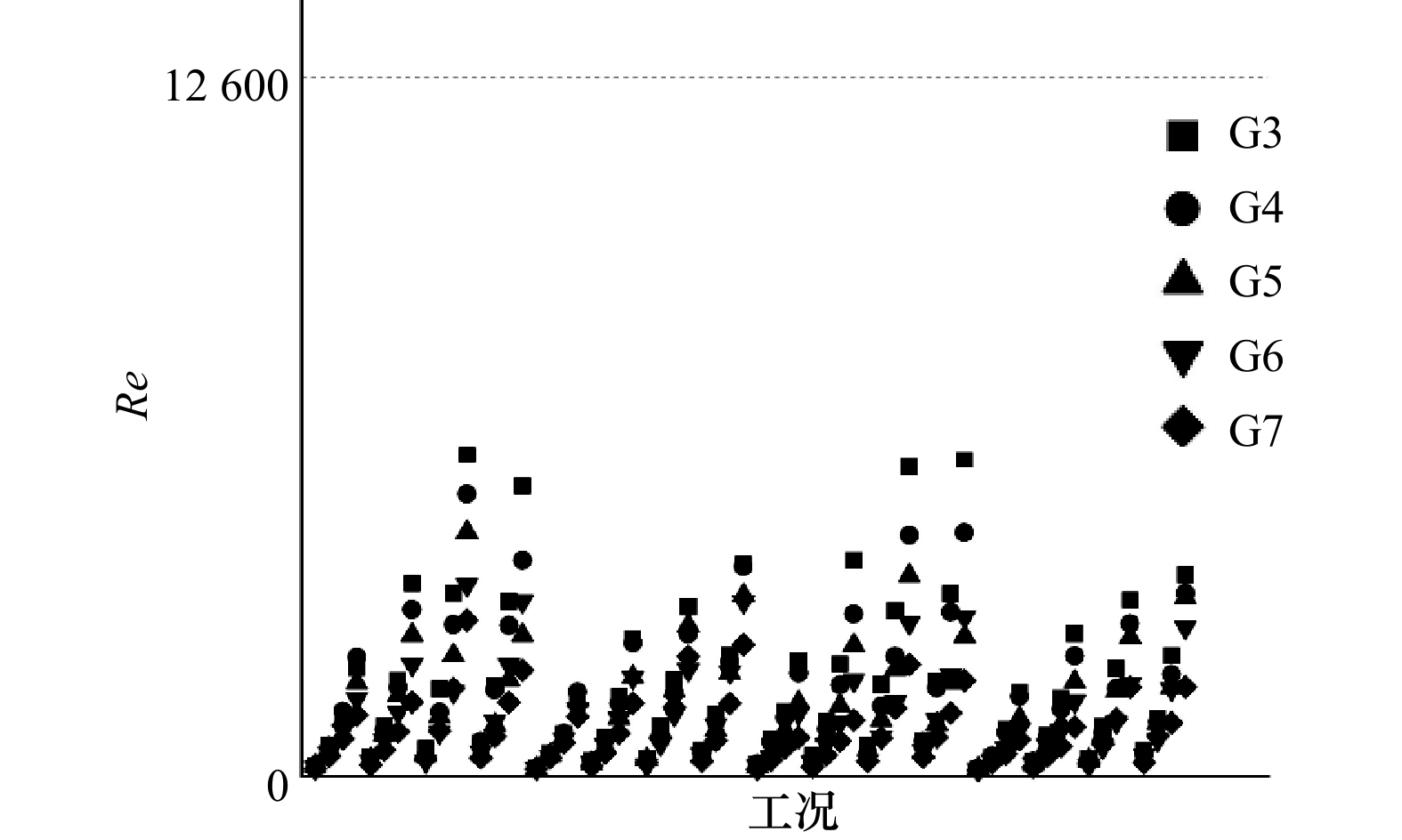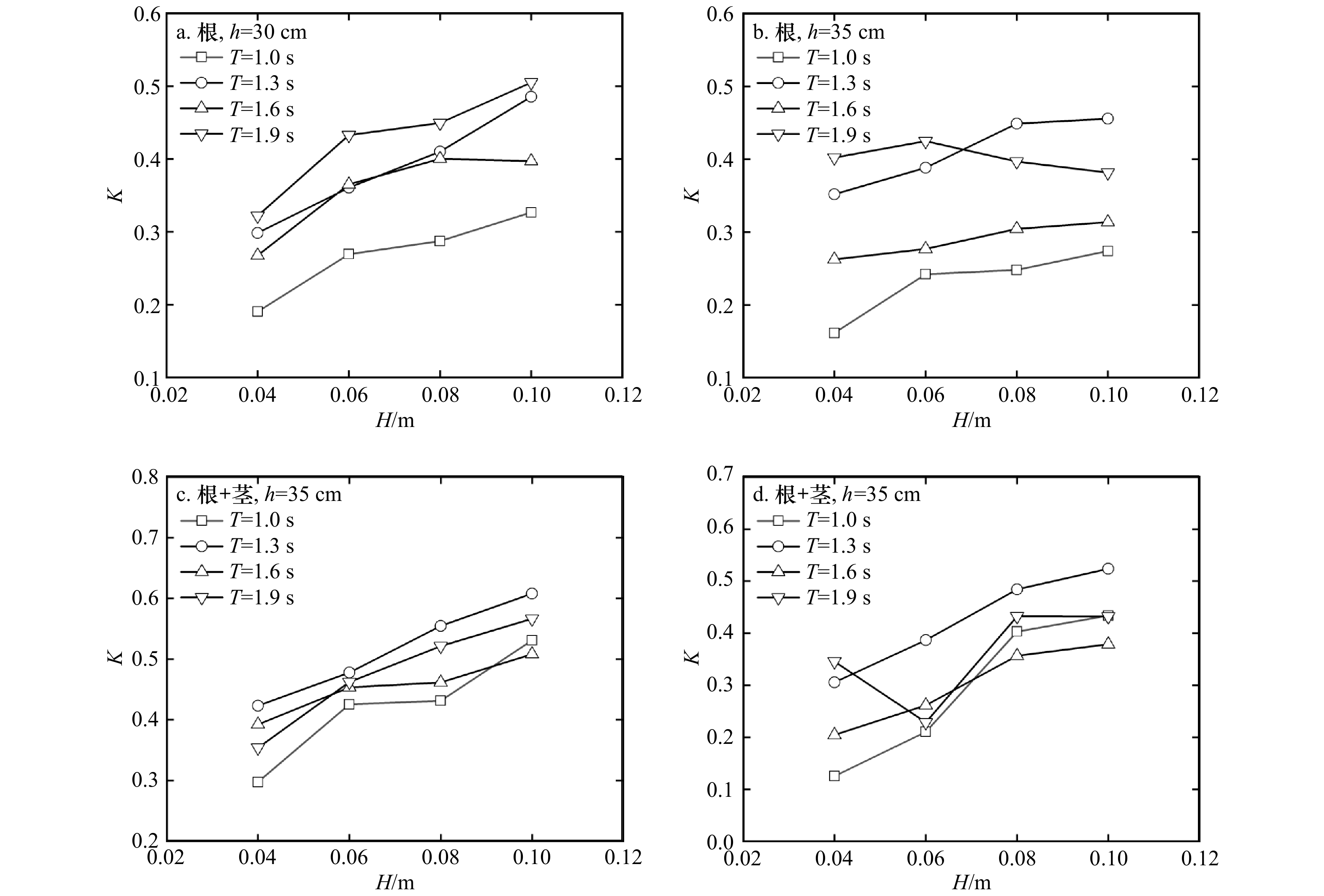Study on the influence of rigid plant roots and stems on the maximum shearing characteristics of boundary layer under regular wave
-
摘要: 基于考虑根茎影响的近岸植物消波实验,对边界层的最大剪切力特性进行了研究。利用前人提出的规则波下含植物水流的边界层流速计算公式,探究了单独根和根茎组合两种植物模型的边界层最大剪切力特性,分析了两种模型的剪切力的沿程变化、植物对剪切力衰减特性的影响,拟合了衰减系数的公式。研究表明,波浪在通过植物带时,剪切力会出现一定幅度增大,随后逐渐降低。植物对剪切力的消减效果随入射波高的增大而增大,且茎有助于根群对边界层最大剪切力的消减作用,其消减系数的范围为0.06~0.61,拟合的公式更加适用于水深较浅的情况。Abstract: The characteristics of the maximum shear force in the boundary layer were studied based on the wave attenuation experiment of nearshore plants considering the influence of roots. The maximum shear force characteristics of the boundary layer under two plant models, root alone and combination of roots and stems, were investigated by using the formula of boundary layer velocity calculation with plant water flow under regular waves proposed by predecessors. The shear force variation along the path and the effect of plants on the shear force attenuation characteristics of the two models were analyzed, and the formulas of the attenuation coefficients were fitted. Studies have shown that when waves pass through the plant zone, the shear force increases to a certain extent and then decreases gradually. The reduction effect of plant on shear force increases with the increase of incident wave height, and the stem contributes to the reduction effect of root group on the maximum shear force of boundary layer, and the reduction coefficient ranges from 0.06 to 0.61. The fitted formula is more suitable for shallow water.
-
Key words:
- generalized plant model /
- boundary layer /
- shear force /
- root /
- stem /
- regular wave
-
表 1 实验工况
Tab. 1 Expermental cases
水深h/cm 周期T/s 波高H/cm 30.0,35.0 1.0,1.3,1.6,1.9 4.0,6.0,8.0,10.0 -
[1] 陈杰, 何飞, 蒋昌波, 等. 植物消波机制的实验与理论解析研究进展[J]. 水科学进展, 2018, 29(3): 433−445.Chen Jie, He Fei, Jiang Changbo. Advances in laboratory experiment, theoretical analysis of mechanism of wave attenuation by vegetation[J]. Advances in Water Science, 2018, 29(3): 433−445. [2] Horstman E, Dohmenjanssen C M, Narra P M, et al. Wave attenuation in mangroves: A quantitative approach to field observations[J]. Coastal Engineering, 2014, 94(12): 47−62. [3] Chen J, Duan Z, Jiang C B, et al. Laboratory study on tsunami erosion and deposition under protection of rigid emergent vegetation[J]. Natural Hazards, 2018, 92(2): 995−1010. doi: 10.1007/s11069-018-3235-x [4] 陈杰, 何飞, 蒋昌波, 等. 规则波作用下刚性植物拖曳力系数实验研究[J]. 水利学报, 2017, 48(7): 846−857.Chen Jie, He Fei, Jiang Changbo, et al. Experimental investigation on drag coefficient of rigid vegetation influenced by regular waves[J]. Journal of Hydraulic Engineering, 2017, 48(7): 846−857. [5] He Fei, Chen Jie, Jiang Changbo. Surface wave attenuation by vegetation with the stem, root and canopy[J]. Coastal Engineering, 2019, 152: 103509. [6] 徐海珏, 胡萍, 白玉川, 等. 木本植被覆盖岸坡上波浪爬升过程的数值模拟研究[J]. 海洋学报, 2020, 42(3): 10−42.Xu Haijue, Hu Pin, Bai Yuchuan, et al. Numerical simulation for wave climbing process on woody plants covered slope[J]. Haiyang Xuebao, 2020, 42(3): 10−42. [7] 唐军, 沈永明, 崔雷. 基于抛物型缓坡方程模拟近岸植被区波浪传播[J]. 海洋学报, 2011, 33(1): 7−11.Tang Jun, Shen Yongming, Cui Lei. Modeling coastal water wave propagation in vegetation field based on parabolic mild slope equation[J]. Haiyang Xuebao, 2011, 33(1): 7−11. [8] Dalrymple R A, Kirby J T, Hwang P A. Wave diffraction due to areas of energy dissipation[J]. Journal of Waterway Port Coastal & Ocean Engineering, 1984, 110(1): 67−79. [9] Husrin S, Strusinska A, Oumeraci H. Experimental study on tsunami attenuation by mangrove forest[J]. Earth, Planets and Space, 2012, 64(10): 973−989. doi: 10.5047/eps.2011.11.008 [10] 曾思益, 陈杰, 蒋昌波, 等. 基于根茎叶概化模型的孤立波消减特性实验[J]. 海洋科学进展, 2019, 37(4): 588−600.Zeng Siyi, Chen Jie, Jiang Changbo, et al. Experimental investigation of the effects of vegetation on solitary wave attenuation based on a generalized model of root, stem and canopy[J]. Advances in Marine Science, 2019, 37(4): 588−600. [11] 彭浩, 陈杰, 蒋昌波, 等. 单株和簇状植物分布方式对消波的影响试验[J]. 水利水电科技进展, 2019, 39(4): 27−34.Peng Hao, Chen Jie, Jiang Changbo, et al. Experimental study on wave attenuation effects by single and patchy rigid vegetation[J]. Water Resources and Hydropower Engineering, 2019, 39(4): 27−34. [12] Luhar M, Coutu S, Infantes E, et al. Wave-induced velocities inside a model seagrass bed[J]. Journal of Geophysical Research: Oceans, 2010, 115: C12005. doi: 10.1029/2010JC006345 [13] 陈杰, 管喆, 蒋昌波. 海啸波作用下泥沙运动——Ⅴ. 红树林影响下的岸滩变化[J]. 水科学进展, 2016, 27(2): 206−213.Chen Jie, Guan Zhe, Jiang Changbo. Study of sediment transport by tsunami waves: V. influence of mangrove[J]. Advances in Water Science, 2016, 27(2): 206−213. [14] 陈杰, 刘静, 蒋昌波, 等. 波浪作用下泥沙运动研究综述[J]. 泥沙研究, 2014(4): 74−80.Chen Jie, Liu Jing, Jiang Changbo, et al. Review of sediment transport under waves[J]. Journal of Sediment Research, 2014(4): 74−80. [15] 陈杰, 蒋昌波, 邓斌, 等. 海啸波作用下岸滩演变与床沙组成变化研究综述[J]. 水科学进展, 2013, 24(5): 750−758.Chen Jie, Jiang Changbo, Deng Bin, et al. Review of beach profile changes and sorting of sand grains by tsunami waves[J]. Advances in Water Science, 2013, 24(5): 750−758. [16] 曹祖德, 孔令双, 焦桂英. 波、流共同作用下的泥沙起动[J]. 海洋学报, 2003, 25(3): 113−119.Cao Zude, Kong Lingshuang, Jiao Guiying. Initiation of sediment movement for a wave-current coexistent system[J]. Haiyang Xuebao, 2003, 25(3): 113−119. [17] Galen E, Marianne C, Oliver F, et al. Observations of near-bed shear stress in a shallow, wave-and current-driven flow[J]. Journal of Geophysical Research: Oceans, 2019, 124(8): 6323−6344. [18] Xu Hua, Xia Yunfeng, Ma Binghe, et al. Research on measurement of bed shear stress under wave-current interaction[J]. Chinese Ocean Engineering Society, 2015, 29(4): 589−598. doi: 10.1007/s13344-015-0041-z [19] 王运洪. 泥沙起动规律的研究[J]. 海洋学报, 1984, 6(6): 874-880.Wang Yunhong. Study on initiation of sediment[J]. Haiyang Xuebao, 1984, 6(6):874−880. [20] Abreu T, Michallet H, Silva P A, et al. Bed shear stress under skewed and asymmetric oscillatory flows[J]. Coastal Engineering, 2013, 73(3): 1−10. [21] Walter B L, Gromke C B, Lehning M, et al. Shear-stress partitioning in live plant canopies and modifications to raupach’s model[J]. Boundary-Layer Meteorology, 2012, 144(2): 217−241. [22] Jonsson I G. Wave boundary layers and friction factors[J]. Coastal Engineering, 1967: 127−148. [23] Tanaka N, Sasaki Y, Mowjood M I M, et al. Coastal vegetation structures and their functions in tsunami protection: Experience of the recent Indian Ocean tsunami[J]. Landscape & Ecological Engineering, 2007, 3(1): 33−45. -





 下载:
下载:






